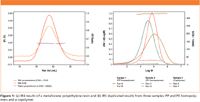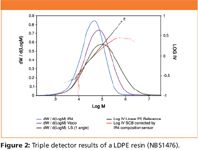High Temperature GPC Analysis of Polyolefins with Infrared Detection
The analysis of the molar mass distribution of polyethylene and polypropylene resins by GPC/SEC has always been considered a demanding task because of the requirement of high temperature operation for dissolution and complex hardware design, which often results in high maintenance cost, in particular related to the autosampler/injector and detector units, and in other problematic and consuming tasks such as solvent handling added to column fragility, sample degradation, or detector sensitivity–stability.
The analysis of the molar mass distribution of polyethylene and polypropylene resins by GPC/SEC has always been considered a demanding task because of the requirement of high temperature operation for dissolution and complex hardware design, which often results in high maintenance cost, in particular related to the autosampler/injector and detector units, and in other problematic and consuming tasks such as solvent handling added to column fragility, sample degradation, or detector sensitivity–stability.
All those considerations were kept in mind in the design of a new high temperature GPC instrumentation.
Instrumentation and Experimental
The analyses are performed in a newly developed modular GPC instrument from Polymer Char, the GPC-IR, which consists of a main body, an autosampler, and a pump.
The main body incorporates two ovens, preventing the columns from suffering during maintenance tasks and, therefore, extending their life; an Agilent GC oven is used for the columns, which can be independently heated up to 220 °C with a temperature control of 0.01 °C. On top of the columns' oven, there is a separate oven, where injector and detectors are located. This design allows preventive maintenance to be performed and the loop volume to be changed without affecting the columns' temperature.
The autosampler is a separate unit with 70 vials of 10 mL attached to the injector/detectors oven through a heated interface. The vials are filled automatically before entering for the dissolution process into a small heated carousel oven. After dissolution time (different dissolution times can be selected for each sample), the sample is automatically filtered meanwhile filling the loop before injection. Vials stay in this carousel oven just the needed time for dissolution, before injection, to minimize sample oxidation.
Additionally, optional nitrogen purging of the vial can be used to prevent further oxidation. Dissolution is facilitated with a gentle shaking of the vial to prevent shear degradation. Up to 3 injections can be performed in the same vial without any dilution among injections.
The concentration detector used is an infrared detector, which is very appropriate for polyolefin analysis as per its demonstrated high sensitivity for this kind of polymers, as well as fast baseline stabilization. Additionally, by incorporating a second wavelength sensor to the same detector, concentration, and composition are measured simultaneously, as the number of branches per 1000C (optionally, a carbonyl sensor can be used for the composition distribution of EVA or EAA resin analysis).
For triple detector GPC analysis, the light-scattering detector HELEOS from Wyatt is easily incorporated on the right side, as well as a four capillary viscometer integrated in the injector/detectors oven.
The analyses have been performed with trichlorobenzene stabilized with 300 ppm of BHT at 1 mL/min as solvent. A sample solution of 18 mg in 9 mL and injection of 200 μL is used with integrated filtration and automated backflush inside the injector/detectors oven. Three columns (30 cm each with 13 μm particles packing) were used at 150 °C. Injector/detectors oven temperature was set at 160 °C.
Results
The analysis of a metallocene polyethylene resin is shown in Figure 1(a) with the infrared detector signals. The orange curve corresponds to a selective absorbance with emphasis in the CH3 region. The red curve corresponds to the concentration signal based on a broadband absorbance of CH2 and CH3, which is used for all the molar mass moments calculation. The ratio of those two signals is directly proportional to the amount of branches or CH3/1000C as shown in purple as a flat line in this homogeneous resin. For high levels of branching or for the composition analysis of propylene-ethylene copolymers the calibration can be obtained with the injection of polypropylene and polyethylene homopolymers as shown in Figure 1(b). The molar mass distribution curves are shown together with the branch content for duplicated analysis of the two homopolymers and a PE copolymer (metallocene resin) with 20 CH3/1000C.

Figure 1
The analysis of a LDPE resin with triple detector (c+visc+LS) is shown in Figure 2, with the molar mass distribution curves as well as the corresponding Mark–Houwink plot.

Figure 2
Conclusions
Fully automated GPC analysis of polyolefins can be performed with no solvent handling and with an internal filtration system with automatic backflush. The modern GPC-IR system incorporates all technical advances to minimize polymer shear degradation and oxidation.
Very good reproducibility and easy baseline integration is obtained with the use of infrared detector. The two wavelengths detector (IR4) is of great value for propylene-ethylene copolymers, for the analysis of branching in ethylene copolymers, or for the analysis of composition distribution in functional copolymers such as EVA, EA.
The analysis of HDPE (pipe resins) with very low number of branches (<10 CH3/1000TC) can be obtained with the IR5 infrared detector.
When analysing resins with triple detector, all detector signals are obtained and processed in a single software package.

Polymer Characterization S.A.
Gustave Eiffel 8, Paterna, Valencia E-46980 Spain
tel. +34 96 131 81 20; fax +34 96 131 81 22
Email: info@polymerchar.com;
Website: www.polymerchar.com

The Benefits of Custom Bonded Silica
April 1st 2025Not all chromatography resins are created equal. Off-the-shelf chromatography resins might not always meet the rigorous purification requirements of biopharmaceutical manufacturing. Custom bonded silica from Grace can address a wide range of separation challenges, leading to real performance improvements. Discover more about the latest innovations in chromatography silica from Grace, including VYDAC® and DAVISIL®.
5 Things to Consider When Selecting a Chromatography Silica
April 1st 2025Particularly in the pharmaceutical industry, drug purity isn’t just a goal – it’s essential for achieving safety, stability and efficacy. However, purification is easier said than done, especially with challenging molecules like DNA and RNA “oligonucleotides,” due in large part to their diversity and the range of impurities that can be generated during production. Enter DAVISIL® chromatographic silica, with a wide range of pore diameters and particle sizes to meet your specific application, performance and sustainability requirements. Before you choose the chromatography resin for your next purification application, take a look at these 5 considerations.
Automating Protein Purification: Efficiency, Yield, and Reproducibility
March 27th 2025Recent advancements in automated protein purification stress the importance of efficiency, scalability, and yield consistency. This eBook compares different purification platforms, highlighting their impact on downstream applications and demonstrating how automation enhances throughput and process control.
MilliporeSigma: Ultrapure Water for Sensitive LC-MS Analysis of Pesticides
March 25th 2025The aim of the study was to illustrate the efficiency of Milli-Q® water purification systems in eliminating pesticides from tap water, thereby producing and delivering reliable and consistent-quality ultrapure water suitable for pesticides analysis















